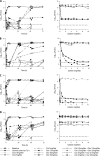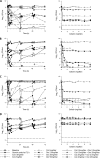The combination of colistin and doripenem is synergistic against Klebsiella pneumoniae at multiple inocula and suppresses colistin resistance in an in vitro pharmacokinetic/pharmacodynamic model
- PMID: 22802247
- PMCID: PMC3457376
- DOI: 10.1128/AAC.01064-12
The combination of colistin and doripenem is synergistic against Klebsiella pneumoniae at multiple inocula and suppresses colistin resistance in an in vitro pharmacokinetic/pharmacodynamic model
Abstract
Multidrug-resistant (MDR) Klebsiella pneumoniae may require combination therapy. We systematically investigated bacterial killing with colistin and doripenem mono- and combination therapy against MDR K. pneumoniae and emergence of colistin resistance. A one-compartment in vitro pharmacokinetic/pharmacodynamic model was employed over a 72-h period with two inocula (∼10(6) and ∼10(8) CFU/ml); a colistin-heteroresistant reference strain (ATCC 13883) and three clinical isolates (colistin-susceptible FADDI-KP032 [doripenem resistant], colistin-heteroresistant FADDI-KP033, and colistin-resistant FADDI-KP035) were included. Four combinations utilizing clinically achievable concentrations were investigated. Microbiological responses were examined by determining log changes and population analysis profiles (for emergence of colistin resistance) over 72 h. Against colistin-susceptible and -heteroresistant isolates, combinations of colistin (constant concentration regimens of 0.5 or 2 mg/liter) plus doripenem (steady-state peak concentration [C(max)] of 2.5 or 25 mg/liter over 8 h; half-life, 1.5 h) generally resulted in substantial improvements in bacterial killing at both inocula. Combinations were additive or synergistic against ATCC 13883, FADDI-KP032, and FADDI-KP033 in 9, 9, and 14 of 16 cases (4 combinations at 6, 24, 48, and 72 h) at the 10(6)-CFU/ml inoculum and 14, 11, and 12 of 16 cases at the 10(8)-CFU/ml inoculum, respectively. Combinations at the highest dosage regimens resulted in undetectable bacterial counts at 72 h in 5 of 8 cases (4 isolates at 2 inocula). Emergence of colistin-resistant subpopulations in colistin-susceptible and -heteroresistant isolates was virtually eliminated with combination therapy. Against the colistin-resistant isolate, colistin at 2 mg/liter plus doripenem (C(max), 25 mg/liter) at the low inoculum improved bacterial killing. This investigation provides important information for optimization of colistin-doripenem combinations.
Figures


Similar articles
-
Synergistic killing of multidrug-resistant Pseudomonas aeruginosa at multiple inocula by colistin combined with doripenem in an in vitro pharmacokinetic/pharmacodynamic model.Antimicrob Agents Chemother. 2011 Dec;55(12):5685-95. doi: 10.1128/AAC.05298-11. Epub 2011 Sep 12. Antimicrob Agents Chemother. 2011. PMID: 21911563 Free PMC article.
-
Synergistic activity of colistin and rifampin combination against multidrug-resistant Acinetobacter baumannii in an in vitro pharmacokinetic/pharmacodynamic model.Antimicrob Agents Chemother. 2013 Aug;57(8):3738-45. doi: 10.1128/AAC.00703-13. Epub 2013 May 28. Antimicrob Agents Chemother. 2013. PMID: 23716052 Free PMC article.
-
Clinically relevant plasma concentrations of colistin in combination with imipenem enhance pharmacodynamic activity against multidrug-resistant Pseudomonas aeruginosa at multiple inocula.Antimicrob Agents Chemother. 2011 Nov;55(11):5134-42. doi: 10.1128/AAC.05028-11. Epub 2011 Aug 29. Antimicrob Agents Chemother. 2011. PMID: 21876058 Free PMC article.
-
Characterization of porin expression in Klebsiella pneumoniae Carbapenemase (KPC)-producing K. pneumoniae identifies isolates most susceptible to the combination of colistin and carbapenems.Antimicrob Agents Chemother. 2013 May;57(5):2147-53. doi: 10.1128/AAC.02411-12. Epub 2013 Mar 4. Antimicrob Agents Chemother. 2013. PMID: 23459476 Free PMC article.
-
Activity of colistin combined with doripenem at clinically relevant concentrations against multidrug-resistant Pseudomonas aeruginosa in an in vitro dynamic biofilm model.J Antimicrob Chemother. 2014 Sep;69(9):2434-42. doi: 10.1093/jac/dku151. Epub 2014 May 15. J Antimicrob Chemother. 2014. PMID: 24833752
Cited by
-
Novel nitroxoline derivative combating resistant bacterial infections through outer membrane disruption and competitive NDM-1 inhibition.Emerg Microbes Infect. 2024 Dec;13(1):2294854. doi: 10.1080/22221751.2023.2294854. Epub 2024 Jan 30. Emerg Microbes Infect. 2024. PMID: 38085067 Free PMC article.
-
Chinese consensus guidelines for therapeutic drug monitoring of polymyxin B, endorsed by the Infection and Chemotherapy Committee of the Shanghai Medical Association and the Therapeutic Drug Monitoring Committee of the Chinese Pharmacological Society.J Zhejiang Univ Sci B. 2023 Feb 15;24(2):130-142. doi: 10.1631/jzus.B2200466. J Zhejiang Univ Sci B. 2023. PMID: 36751699 Free PMC article.
-
Polymyxins, the last-resort antibiotics: Mode of action, resistance emergence, and potential solutions.J Biosci. 2021;46(3):85. doi: 10.1007/s12038-021-00209-8. J Biosci. 2021. PMID: 34475315 Free PMC article. Review.
-
New Insight on Epidemiology and Management of Bacterial Bloodstream Infection in Patients with Hematological Malignancies.Mediterr J Hematol Infect Dis. 2015 Jul 1;7(1):e2015044. doi: 10.4084/MJHID.2015.044. eCollection 2015. Mediterr J Hematol Infect Dis. 2015. PMID: 26185609 Free PMC article. Review.
-
Risk Factors for the Development of Colistin Resistance during Colistin Treatment of Carbapenem-Resistant Klebsiella pneumoniae Infections.Microbiol Spectr. 2022 Jun 29;10(3):e0038122. doi: 10.1128/spectrum.00381-22. Epub 2022 Jun 2. Microbiol Spectr. 2022. PMID: 35652641 Free PMC article.
References
-
- Antoniadou A, et al. 2007. Colistin-resistant isolates of Klebsiella pneumoniae emerging in intensive care unit patients: first report of a multiclonal cluster. J. Antimicrob. Chemother. 59:786–790 - PubMed
Publication types
MeSH terms
Substances
Grants and funding
LinkOut - more resources
Full Text Sources
Medical
Molecular Biology Databases

